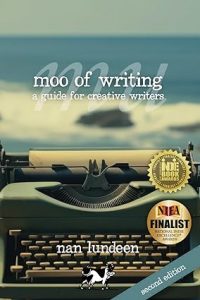Moo of Writing: a Guide for Creative Writers
Moo of Writing: a Guide for Creative Writers
By Nan Lundeen
 Today we need a lightness of being. We need Wordsworth’s daffodils and the wisdom of Mary Oliver’s dog Percy whose bottom line on how to live her life after she asks his advice is “trust.”
Today we need a lightness of being. We need Wordsworth’s daffodils and the wisdom of Mary Oliver’s dog Percy whose bottom line on how to live her life after she asks his advice is “trust.”
When three a.m. thoughts rummage around in my mind with their anxiety-producing pronouncements, the only comfort I find is to take up my pen.
My pen is my instrument of prayer.
It is a way I know to seek community and to grasp a remnant of hope. I would tell you it is my life raft in stormy seas, but I dare not because I have written a book on how to write, and I discourage using clichés.
Some would suspect I place too much weight on the shoulders of my disposable pen which is only slightly more disposable than me. Yet I cling to this habit of writing as dearly as I cling to life at age eighty.
I am driven to share the magic of writing with all who pick up my newly released book, ‘Moo of Writing: a guide for creative writers.’ I hope they find sustenance in its pages. I say in the intro to this second edition that this book demanded to be written, and that is true. But aren’t there already enough books on how to write on the market, some of them profound?
Yes, but it is what I do. I feel compelled to share my love of writing and inspiration I have gleaned from forty years in the business. I have compiled an updated handbook of how and why the Moo process works.
You can spell the process either “Moo” or “Mu.”
Moo depends upon, like dairy cows, relaxation, and rumination as a form of contemplation, which can result in superb productivity. Dairy cows produce up to five gallons of milk per day.
I respectfully borrow Mu, a Zen koan that like all koans defies description, to symbolize stepping aside and letting the work happen, much like hands shaping clay into a pot while the wheel spins. You cannot force a result. Instead, the writer draws upon meditation and a practice of freewriting from which creativity blossoms—creativity previously sequestered in the subconscious.
Scientific research into creativity at major universities, which has expanded significantly since the millennium, reveals that this process works, and offers tools to set about using it.
Studies show that walking boosts creativity by as much as sixty percent. What better way to boost brain power than through the regular exercise of your choice?
Moodling, a form of rumination, provides a slanted pathway into ideas. Successful authors praise meditation. It is a doorway to relaxed writing. Similarly, researchers have discovered that creativity thrives in a space between wakefulness and sleep.
Other researchers have developed a system called a “habit loop.” We can loop around our busy lives a new habit of cue-routine-reward that establishes a dependable practice of daily freewriting.
Freewriting time became more accessible to me during the pandemic, and I was forced to rely more upon my Moo/Mu process as I put together a chapbook of poems, searching for the creative force with limited exposure to life outside my writing room. We helped our elementary-school-age grandson, who spent a few days every week with us, with his online education. I studied poetry for a course I was taking online. My husband went out into the world, masked, to work in a grocery store and help keep food flowing in the community.
Inspiration came to me via a blue barn tucked into woods between a cottage and wetlands filled with cattails, brown but brilliant in the solid work that they do even in winter. I would slow down as I drove past the barn nearly hidden among maples and pines on my way to the library. I imagined inviting Monet for a cup of tea in the hayloft. When I returned home, I went for a walk, sat in my ruminating rocking chair, meditated, and wrote freely. The blue barn comforted me with a series of poems through the changing seasons.
When I began research for a second edition of ‘Moo of Writing: a guide for creative writers,’ I was happy to discover more scientific support that the principles that work for me prove effective. Participants in my workshops find the process useful. I love sharing it.
Even when fear and self-doubt pound on our door, demanding entry, we need faith that an abundance of words awaits us, that they can be plucked from our inner selves, and that they are worth sharing. A sense of wonder will not abandon us because when hope lies gasping at the bottom of a well, we find our way to the page.
—
Nan Lundeen is a poet, award-winning journalist, and writing workshop facilitator. She holds a master’s in communication from Western Michigan University. Visit her at www.nanlundeen.com
MOO OF WRITING: A GUIDE FOR CREATIVE WRITERS
 ‘Moo of Writing: a guide for creative writers’ brims with self-affirming information that reaches deep. A recent surge in studies on the sources of creativity supports the processes Nan Lundeen recommends: exercise, relaxation, and meditation spiced with a liberal dose of freewriting.
‘Moo of Writing: a guide for creative writers’ brims with self-affirming information that reaches deep. A recent surge in studies on the sources of creativity supports the processes Nan Lundeen recommends: exercise, relaxation, and meditation spiced with a liberal dose of freewriting.
Discover how to unmask your hidden fears; create a freewriting habit loop that will help you find time to write; stay grounded and consult your belly wisdom; and stay safe in the publishing world. Writing tips, writing exercises, and meditations round out this inspirational book.
This second edition builds upon the foundation of Nan’s first edition that won a finalist spot in the 2017 Next Generation Indie Book Awards and the 2016 National Indie Excellence Awards, writing and publishing category.
Says UK Writing Magazine Tutor Sue Johnson: “Moo of Writing has an important place on my bookshelf. I have three words on my desk as a reminder – walk, meditate, write. There is never enough time, so I make the most of every spare minute to relax and let the words flow.”
https://www.amazon.com/dp/B0CW1GLTJ1
Category: On Writing






























